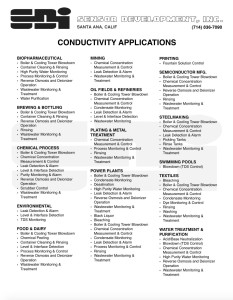
Conductivity Applications
READ MORE March 31st, 2020
March 31st, 2020 admin
admin
-
 Best Practices & Methods
Best Practices & Methods
-
 0 Comments
0 Comments

Conductivity Error Reduction Techniques: Bubbles
Make sure the sensor does not trap or collect air bubbles on the surface when on-line. This is a common and little appreciated problem because you cannot see through most piping. To test for surface bubbles, rap the back of an on-line sensor sharply with a screwdriver handle and look for a step change up in the conductivity reading. If it jumps suddenly, odds are good that the rap dislodged bubbles from the electrode surfaces.
READ MORE March 30th, 2020
March 30th, 2020 admin
admin
-
 Best Practices & Methods
Best Practices & Methods
-
 0 Comments
0 Comments
RoHS COMPLIANT SENSORS AVAILABLE
Sensor Development, Inc. has placed great importance on ensuring that our products comply with European Directive 2011/65/EU, comm
READ MORE July 11th, 2016
July 11th, 2016 admin
admin
-
 Best Practices & Methods
Best Practices & Methods
-
 2 Comments
2 Comments

Polarization
Ions traveling toward the electrodes will quickly form dense clouds near the electrode surfaces. They cannot physically cross the solid/liquid barrier, and the voltage is usually too low for significant electrolysis to occur (forming elemental sodium and chlorine gas for our example.) But the cloud of negative ions will present a rising counter emf at the positive electrode, and vice-versa. The result is that current flow rapi
READ MORE April 7th, 2014
April 7th, 2014 admin
admin
-
 Best Practices & Methods
Best Practices & Methods
-
 0 Comments
0 Comments


